Greenhouse Gambling
Air Date: Week of May 22, 2009
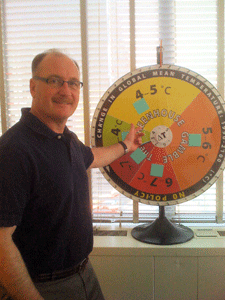
John Reilly and the MIT Greenhouse Gamble. (Photo: Steve Curwood)
Cutting emissions might not keep the planet from heating up, but it would increase our odds of seeing less extreme temperature increases by the end of the century. MIT climate change researchers have worked those odds into a roulette wheel. Economist John Reilly let’s host Steve Curwood give it a spin to see what luck-- and different emissions paths-- might mean for our planet and its residents.
Transcript
CURWOOD: As the climate change bill works its way through Congress, new research at the Massachusetts Institute of Technology is showing that time for effective action on global warming is running out.
MIT scientists were so startled by the results of their latest efforts at climate modeling that it took them nearly three years of checking and double checking before publication—
If no action is taken the MIT group now expect temperatures to increase twice as much as previously thought.
Mixed in this forecast are probabilities of the likelihood of particular climate outcomes, and to illustrate the odds of risk, the MIT Global Change Program has built a wheel of chance. It looks like something Vanna White would spin on the Wheel of Fortune, and the scientists call it the Greenhouse Gamble:
REILLY: When you spin it, if you get unlucky you get high temperatures, and if you get lucky you get low temperatures. And it really signifies what we as humanity are doing, we're spinning a wheel, by putting emissions up in the atmosphere and we don't, at this point, know where it will stop.
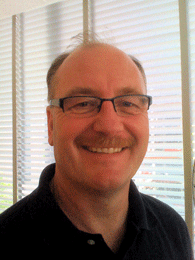
MIT economist John Reilly. (Photo: Steve Curwood)
[SPINNING SOUND]
CURWOOD: First, we spun the wheel to see how much hotter the planet might get by the end of the century if we do NOTHING to cut our greenhouse gas emissions.
[SPINNING SOUND]
REILLY: Okay, you've landed on the thing that says five to six degrees centigrade, a pie wedge that says that. That’s actually about the median forecast of what we’re getting. In the previous work we were thinking the median was more two and a half degrees and the highest, highest amounts we got approached five degrees. So now we have more than half of the wheel at above five degrees. So, you know, that is really a hot planet. [Laughing]
CURWOOD: So what’s happened to change your estimate of what’s going on? Is it that we’ve dumped more carbon into the atmosphere since you first did the study or are you getting better in your studies or what?
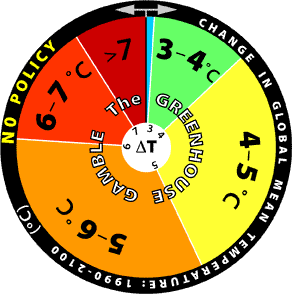
If we continue our current emissions path, we’re likely to see average global temperatures increase by at least five degrees Celsius.
CURWOOD: Alright, let’s give it another spin here.
[SPINNING SOUND]
REILLY: Oh this is not good. I’m sorry. The is all the way up to six to seven degrees assuming that we do nothing about climate change. So this is a really severe outcome. You know, combine that with seven degrees, it’s a twenty percent chance. And a twenty percent chance of going that high is a pretty large risk of pretty catastrophic results.
CURWOOD: Alright, now let’s give it a spin based on what you would call – what – very strong action, sharp reductions.
REILLY: Yes, this is the sort of wheel we’d be facing if we moved ahead with some of the bills in Congress now, and the U.S. did that and the rest of the world followed along with similar sorts of things. This is the sort of wheel we’d be facing if we actually adopted that policy.
CURWOOD: So what do you say – let’s give it a spin.
REILLY: Sure.
[SPINNING SOUND]
REILLY: So in this spin we’ve done as well as we can possibly do with this policy, and we’re still getting one to two degrees of warming. So that’s kind of the minimum we can expect if we are really aggressive to reduce greenhouse gases and we get really lucky.
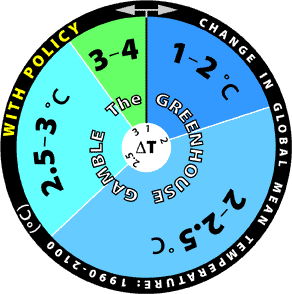
If we cut emissions, we’re still likely to see average global temperatures to increase by more than two degrees.
REILLY: About fifteen or eighteen percent of getting in that slice.
CURWOOD: So in other words, if you do the flip side of that, even with aggressive action we’re looking at better than eighty percent chance that we’re heading into a very uncomfortable zone.
REILLY: More than two degrees.
CURWOOD: And what would it mean if global average temperature went up by two degrees or three degrees centigrade?
REILLY: Temperature increases of two to three degrees are thought to be the point where you’d have ice free Artic and melting of the Greenland Ice Sheet or West Antarctic Ice Sheet, could raise sea levels by meters. And so that would be a very dramatic change. How fast that would happen is unclear, but once we get to that level, we’ve really then started probably an irreversible process.
CURWOOD: So these numbers are all based on going forward from today, but we already have – what- seven, eight tenths of a degree centigrade warming in the atmosphere.
REILLY: That’s correct.
CURWOOD: So, what are the odds of pretty much keeping the climate regime that we’ve got today?
REILLY: Well, there’s no chance of that. [Laughs] Even if we stopped all emissions of greenhouse gases this minute, there’s inertia build in the system that would continue to have warming of as much as a half of a degree between now and 2050 without anymore increase in greenhouses gases. And there’s no way the world is going to turn on a dime and we’re all going to stop driving our cars and turning on our lights tomorrow. And so even with the most intense efforts to reduce greenhouse gases, there’s going to be more emissions.
CURWOOD: Somebody listening to us might say “Huh, okay. So like we have an 80 percent chance of things being really very difficult, even if we have aggressive policies. Why bother?” What would you say to them?
REILLY: If we don’t bother it’s going to be much, much worse. In this debate there’s this idea that we’re already gone over a cliff or something and that leads to the frustration that, well, if we’ve gone over the cliff, why bother? Unfortunately there may be little cliffs, but there’s many more cliffs to come. And so, we’re stuck with, I think, probably something on the order of two and a half to three or four degrees warming even if we do almost everything we can. So we’re gonna have to be prepared for adapting to the climate change we see and really worry about, you know, risk to agriculture, to coastal systems, to severe storms, to increased hurricanes, to melting of ice. The risks are there and I think they’re, at this point, some of them are unavoidable, but we certainly want to move ahead as fast as we can to avoid these really catastrophic outcomes.
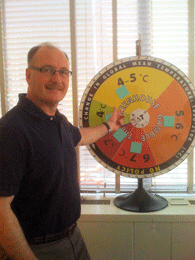
John Reilly and the MIT greenhouse gambling wheel. (Photo: Steve Curwood)
REILLY: Well, you know, we scientists we’re ducks, right? So, this is an incredibly fascinating problem for us [laughing]. So, it’s an interesting research topic. So, I guess I still sleep, but [laughing] I try not to think about what the real consequences are.
CURWOOD: John Reilly is with the Climate Modeling Group at MIT. Thank you so much.
REILLY: Thank you.
[MUSIC: Carlos Santana “Blues For El Salvador” from Multi Dimensional Warrior (Legacy records 2008)]
YOUNG: Coming up – an egg hunt to help birds survive farm country. Keep listening to Living on Earth.
[CUTAWAY MUSIC: Thomas Marriott “You Only Live Twice” from Flexicon (Origin Records 2009)]
Links
For more on the Greenhouse Gamble, click here.
Click here for more on the The MIT Joint Program on the Science and Policy of Global Change.
Living on Earth wants to hear from you!
Living on Earth
62 Calef Highway, Suite 212
Lee, NH 03861
Telephone: 617-287-4121
E-mail: comments@loe.org
Newsletter [Click here]
Donate to Living on Earth!
Living on Earth is an independent media program and relies entirely on contributions from listeners and institutions supporting public service. Please donate now to preserve an independent environmental voice.
NewsletterLiving on Earth offers a weekly delivery of the show's rundown to your mailbox. Sign up for our newsletter today!
 Sailors For The Sea: Be the change you want to sea.
Sailors For The Sea: Be the change you want to sea.
 The Grantham Foundation for the Protection of the Environment: Committed to protecting and improving the health of the global environment.
The Grantham Foundation for the Protection of the Environment: Committed to protecting and improving the health of the global environment.
 Contribute to Living on Earth and receive, as our gift to you, an archival print of one of Mark Seth Lender's extraordinary wildlife photographs. Follow the link to see Mark's current collection of photographs.
Contribute to Living on Earth and receive, as our gift to you, an archival print of one of Mark Seth Lender's extraordinary wildlife photographs. Follow the link to see Mark's current collection of photographs.
 Buy a signed copy of Mark Seth Lender's book Smeagull the Seagull & support Living on Earth
Buy a signed copy of Mark Seth Lender's book Smeagull the Seagull & support Living on Earth

